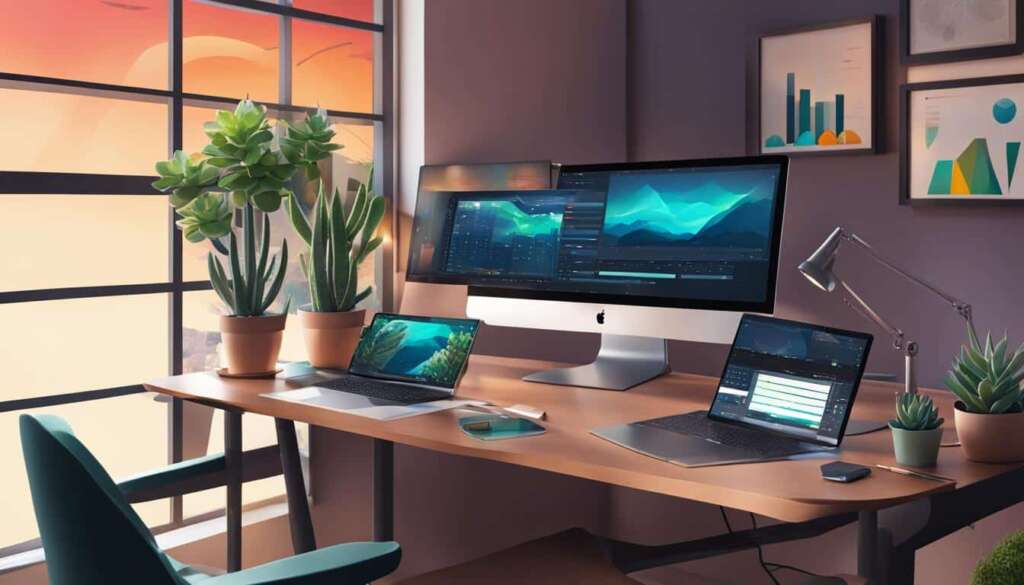Table of Contents
Welcome to our comprehensive guide on setting up a dual monitor setup for your PC. If you want to maximize your productivity and make the most out of your screen real estate, a dual monitor setup is a game-changer. With multiple monitors, you’ll have the ability to multitask efficiently, whether you’re working on office tasks, browsing the web, or indulging in your favorite games.
Why settle for one screen when you can have two? Having an extended workspace gives you the freedom to keep different applications open simultaneously, streamlining your workflow and reducing the time spent switching between tabs or windows. With more screen real estate at your disposal, you can have your documents on one screen while referring to research material or videos on the other.
But before you dive into the exciting world of dual monitors, there are some important things you need to know. In this guide, we’ll walk you through the process of choosing the right monitors for your setup, setting up a dual monitor mount for improved ergonomics, and configuring your PC to work seamlessly with two screens.
Whether you’re a professional seeking increased productivity or a gamer looking for an immersive experience, this guide has got you covered. Let’s get started on your journey to a more efficient and enjoyable computing experience with a dual monitor setup on your PC!
Choosing the Right Monitors for Your Dual Monitor Setup
When it comes to creating a dual monitor setup, selecting the right monitors is crucial. Consider the following factors to ensure an optimal experience:
Monitor Size
One of the key considerations is the size of the monitors. For a cohesive and balanced setup, most users prefer monitors of the same size. This ensures that the display elements align seamlessly and provide a consistent viewing experience across both screens.
Aspect Ratio, Resolution, and Color
Another important consideration is the aspect ratio, resolution, and color capabilities of the monitors. Matching these specifications allows for a visually appealing and harmonious dual monitor setup. It is recommended to have monitors with the same resolution to avoid any compatibility issues and maintain a cohesive look and feel.
Input Types
Make sure to check the input types supported by the monitors and ensure compatibility with your PC. Common input types include HDMI, DisplayPort, and VGA. Select monitors that offer the necessary input options to connect to your computer efficiently.
Panel Types
Panel type refers to the technology used in the monitors, such as IPS, TN, or VA. Each panel type has its advantages and disadvantages in terms of color reproduction, response time, and viewing angles. Consider your specific needs, whether it be accurate color representation for graphic design or fast response times for gaming, and choose the panel type accordingly.
To provide a visual representation of the different monitor specifications, here’s a table showcasing some popular monitor options:
| Monitor | Size | Resolution | Panel Type |
|---|---|---|---|
| Monitor 1 | 27 inches | 2560×1440 | IPS |
| Monitor 2 | 24 inches | 1920×1080 | TN |
| Monitor 3 | 32 inches | 3840×2160 | VA |
The table above showcases three different monitors with varying sizes, resolutions, and panel types. Consider these specifications when choosing the right monitors for your dual monitor setup.
Now that you understand the key factors to consider when selecting monitors, you can make an informed decision to create an optimized dual monitor setup. With the right monitors in place, you’ll enhance your productivity, multitasking capabilities, and overall computing experience.
How to Set Up a Dual Monitor Mount
While most monitors come with their own stands, using a dual monitor mount can provide more flexibility and allow for better positioning of the monitors. It is important to choose a monitor mount that is compatible with your monitors, such as a VESA mount. A monitor arm or wall mount can help improve your posture and make it easier to adjust the position of your monitors. Consider the ergonomics and aesthetic appeal when selecting a monitor mount for your dual monitor setup.
The dual monitor mount provides the ability to adjust the height, tilt, and swivel of your monitors, allowing you to find the most comfortable and ergonomic viewing position. This flexibility is especially beneficial for long work hours or gaming sessions, as it helps reduce strain on your neck, back, and eyes.
When choosing a monitor mount, make sure it is compatible with your monitors’ VESA mounting pattern. VESA mount is a standard that ensures compatibility between different monitor models and brands. Most monitors have a VESA pattern of either 75x75mm or 100x100mm, so ensure that the monitor mount supports the same pattern.
Consider the weight capacity of the monitor mount to ensure it can safely support the weight of your monitors. A sturdy and durable mount will provide a stable and secure setup.
Once you have chosen the right dual monitor mount, follow the manufacturer’s instructions for installation. Typically, the mount will attach to your desk using a clamp or through a grommet hole. Ensure that the mount is securely fastened to avoid any accidents or instability.
After installing the mount, attach your monitors to the VESA plate using the provided screws. Make sure the monitors are securely attached to prevent any wobbling or shifting during use.
Once the monitors are attached to the mount, you can adjust their position to your liking. Tilt, rotate, and swivel the monitors to achieve the optimal viewing angle. This will allow you to comfortably view both screens without straining your neck or eyes.
Investing in a dual monitor mount not only enhances the aesthetics of your workspace but also improves your overall productivity and comfort. With the ability to adjust and position your monitors precisely, you can create an ergonomic and efficient work environment.
How to Set Up Dual Monitors on Your PC
Setting up dual monitors on your PC is a simple and effective way to enhance your productivity and multitasking capabilities. With dual monitors, you can have more screen real estate to work with, allowing you to have multiple applications and windows open simultaneously without constantly switching between them. Here’s a step-by-step guide to help you set up dual monitors on your PC.
Positioning and Plugging In
First, position the monitors on your desk in a way that provides optimal viewing angles and reduces strain on your neck and eyes. Ensure that both monitors are securely placed and at a comfortable height. Next, locate the available ports on your PC, typically HDMI, DisplayPort, or VGA ports, and plug in the corresponding cables to your monitors. Make sure the cables are securely connected to both the monitors and the PC.
Display Settings
Once the physical setup is complete, it’s time to configure the display settings on your PC. In Windows 10 and Windows 11, right-click on the desktop and select “Display Settings” from the context menu. This will open the display settings window, where you can customize various aspects of your dual monitor setup.
First, you can rearrange the displays to match the physical layout of your monitors by clicking and dragging them in the settings window. This ensures that the cursor moves seamlessly between the monitors as you navigate across the screens.
Next, you can adjust the resolution and scaling of your monitors to ensure that the content appears clear and readable. It’s recommended to set the resolution to the native resolution of your monitors for the best visual experience.
Lastly, you can choose how the monitors behave by selecting options such as extend, duplicate, or show content on one monitor only. The “extend” option allows you to use both monitors as one large desktop space, while the “duplicate” option mirrors the same content on both screens. Choose the option that suits your workflow and preferences.
Follow the on-screen instructions to apply the desired settings, and voila! You have successfully set up dual monitors on your PC. Enjoy the expanded screen real estate and boost your productivity with a more efficient and organized workspace.
FAQ
How can setting up a dual monitor setup enhance my productivity?
Setting up a dual monitor setup on your PC can greatly enhance your productivity by providing more screen real estate for web browsing, office work, gaming, and multitasking. With multiple monitors, you can easily switch between tasks and have all your necessary information in view at the same time.
What factors should I consider when choosing monitors for a dual monitor setup?
When choosing monitors for your dual monitor setup, consider factors such as size, aspect ratio, resolution, color, input types, and panel types. It is recommended to have monitors of the same size and resolution to avoid compatibility issues and maintain a consistent look across both screens.
Should I use a dual monitor mount for my setup?
Using a dual monitor mount can provide more flexibility and better positioning of the monitors. Consider a monitor mount that is compatible with your monitors, such as a VESA mount. A monitor arm or wall mount can also improve your posture and make it easier to adjust the position of your monitors.
How do I set up dual monitors on my PC?
Setting up dual monitors on your PC is a straightforward process. Start by positioning the monitors on your desk and plugging them into the available ports on your PC. In Windows 10 and Windows 11, you can access the display settings by right-clicking on the desktop and selecting “Display Settings.” From there, you can rearrange the displays, adjust the resolution and scaling, and choose how the monitors behave (extend, duplicate, or show content on one monitor only). Follow the on-screen instructions to complete the setup process.







